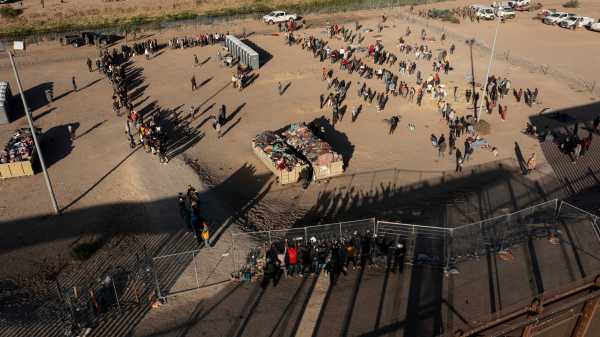Despite the relative calm, the Biden administration faces court challenges that they say may undermine efforts to deal with record levels of border crossings.
-
Send any friend a story
As a subscriber, you have “>10 gift articles to give each month. Anyone can read what you share.
Give this article
Video

Migrants seeking asylum in the United States crossed the Rio Grande and camped out along the border.Credit
The southern border of the United States was crowded with migrants on Friday, but not chaotic, following the lifting of Title 42 pandemic-era restrictions. Yet Biden administration officials lashed out at court challenges from the right and left that they said could undermine efforts to deal with record levels of border crossings in the days and weeks ahead.
Migrants continued to seek refuge in the United States in numerous pockets across the 2,000-mile border with Mexico, though U.S. Border Patrol officials and shelter operators said the flow of desperate people was lighter than they had feared it could be, given how many people had traveled north from their homes in recent weeks.
Even as they expressed relief at the lower-than-expected surge on Friday, administration officials seethed about court rulings that they predicted would hamper their ability to deal with the latest increase in arrivals and lead to dangerous overcrowding at already jammed border facilities.
Alejandro N. Mayorkas, the secretary of the Homeland Security Department, criticized a late Thursday ruling by a federal judge in Florida that blocked the department from releasing migrants without a notice to appear in immigration court, something he said had been done routinely by prior administrations to speed up the process and relieve overcrowding. The ruling came at the request of Florida’s Republican attorney general, who argued that the government cannot simply release the migrants into the country without an order to face a court hearing.
Karine Jean-Pierre, the White House press secretary, called the ruling “sabotage, pure and simple.”
Officials also criticized human rights groups, who filed a lawsuit just after midnight challenging a new Biden administration rule limiting who qualifies for asylum. Migrant rights activists on Friday called the new rule the “Biden-Harris asylum ban” and said it was blatantly illegal. But administration officials said the court challenges would only make the situation worse on the border.
“The lawsuits we are facing frankly from both sides of the aisle really clearly demonstrate just how fundamentally broken our immigration system is,” said Blas Nuñez-Neto, the assistant secretary for border and immigration policy at the Homeland Security Department.
Image

As of early Friday morning, U.S. Border Patrol was holding more than 24,000 migrants in custody.Credit…Todd Heisler/The New York Times
In Washington, a bipartisan group of House lawmakers sought to offer a compromise solution, filing a bill on Friday to extend for two years the government’s authority to immediately expel migrants attempting to enter the country unlawfully, much like they could during the pandemic.
But the bill, led by Representatives Brian Fitzpatrick, Republican of Pennsylvania, and Jared Golden, Democrat of Maine, faces little chance of becoming law. It has already been criticized by some Democrats as too draconian and by some Republicans as doing too little to restrict migrants from making what they consider to be frivolous asylum claims.
Along the border on Friday, there were few scenes of large or unruly crowds at the usual crossing points.
But in comments to reporters on Friday morning, several top administration officials said they continue to expect record levels of border crossings in what they called a “difficult transition” that could stretch well into the summer months.
About 10,000 people crossed the border on Thursday, a historically large number that strained the government’s network of border patrol facilities as well as the shelters run by cities, nonprofit groups and churches.
As of early Friday morning, the Border Patrol was holding more than 24,000 migrants in custody, according to internal data obtained by The New York Times. That is more than a typical day in November last year, when there were 12,000 migrants in Border Patrol custody and well over the agency’s maximum capacity of between 18,000 and 20,000.
In McAllen, Texas, the surge that many expected did not materialize at the McAllen-Hidalgo International Bridge, where Customs and Border Protection officers were processing a small line of people entering the United States from Reynosa, Mexico, many of them regular crossers.
The first group to surrender to the authorities and seek asylum — a mix of men, women and young children — reached the port of entry minutes after Title 42 expired. A row of Texas State Police trucks idled steps away from the international bridge.
ImageMigrants who were processed by Border Patrol rest at a Catholic Charities shelter in McAllen, Texas, on Friday.Credit…Verónica G. Cárdenas for The New York Times
In El Paso, dozens of migrants had gathered around Sacred Heart Church, a respite destination that was overwhelmed with some 2,000 migrants earlier this week. On Friday, some were kicking a soccer ball back and forth, and others were sitting with their backs up to a wall, surrounded by red cross blankets and plastic bags of food.
Shelter operators said that the population in their care decreased on Friday, but that it was too soon to tell what could unfold in coming days, since most people who crossed were still being processed. But some predicted that the worst might have passed.
“The number of people that were picked up from the river levee on the other side of the wall yesterday was significant, but not nearly what everyone expected it was going to be,” said Ruben Garcia, the director of the Annunciation House organization, which coordinates with U.S. Border Patrol for migrant care at a network of shelters in the El Paso area.
“We’ll have to see what happens in the next few days,” he said. “There are many variables.”
Despite the relative calm, officials said the situation on both sides of the border remains difficult with tens of thousands of migrants who have either already crossed into the United States or are headed there. Economic and political crises in countries around the region are driving people to flee their countries in a mass migration that experts say involves as many as 20 million displaced people in the hemisphere. The migration is already straining refugee services around the region, and especially in the United States.
Mexico’s foreign minister, Marcelo Ebrard, offered an optimistic characterization of the situation Friday morning, saying that the border “is calm and normal, with no major arrivals or conflicts.”
But weather forecasters predicted some heavy rain along the border over the weekend, with isolated pockets of up to 10 inches that could lead to flooding along the Rio Grande, which many of the migrants attempt to cross. Hail and damaging winds could also accompany some of these storms, and Saturday tornadoes were also possible, forecasters said.
ImageMigrants waiting for their turn to be processed by agents after crossing the border into San Diego, Calif.Credit…Mark Abramson for The New York Times
In particular, they said there was the potential for flooding along the Rio Grande from Eagle Pass to Laredo, Texas, reaching levels not seen along that portion of the river in several years.
While the focus on Friday was on the immediate flow of migrants at the border, advocates for migrants and officials in Washington engaged in a heated debate about what immigration policies to pursue over the longer term.
On Friday afternoon, several human rights groups demanded that the Biden administration stop enforcing its new asylum rule, which presumes that most migrants crossing into the United States through Mexico would be ineligible for asylum if they do not cross at the official ports of entry.
Kica Matos, president of the National Immigration Law Center, compared the policy to those of former President Donald J. Trump, and said the new policies violate international human right conventions.
“The administration has made a deliberate choice to severely limit access to our country’s asylum system, doubling down and building on Trump policies that go against the core of what are American values,” she said. “Lives are at stake. The administration needs to do better.”
Biden administration officials vehemently defended their approach, saying that tougher measures were needed in the face of huge migration flows across the hemisphere.
Mr. Mayorkas said the administration had been preparing for years for the end of the Title 42 restrictions, and he expressed confidence that new policies — including more legal pathways for migrants as well as tough new consequences for those who try to cross illegally — would eventually reduce the number of people who try to enter the United States without authorization.
“We continue to communicate to migrants that this is not the way to seek relief in the United States,” he told ABC News. “It’s extraordinarily dangerous. They are in the hands of ruthless smugglers. We have built lawful, safe and orderly pathways for them to come to the United States. They are going to meet tough consequences if they arrive at our border irregularly.”
Still, Mr. Mayorkas said it would take time for those efforts to work.
“It’s going to be challenging, but we have a plan,” he said. “We’ve been executing on our plan. It will take time, but we have confidence that our plan will work.”
Reporting was contributed by Nicholas Bogel-Burroughs from Edisto Beach, S.C., Edgar Sandoval from McAllen, Texas, Emiliano Rodríguez Mega from Ciudad Juárez, Miriam Jordan from El Paso, and Karoun Demirjian from Washington.
Source: nytimes.com



